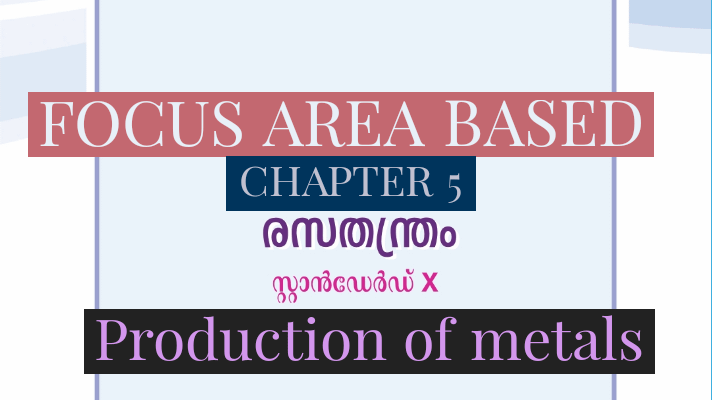
Now,We are going to discuss about one of the important topic of focus area chemistry chapter 5,Production of metals
A mineral, from which a metal is economically, easily, extracted, is called the Ore of the metal
The characteristics of minerals that are used for the extraction of metals
• Abundance • Easily and cheaply separable •High metal content
Download now CHEMISTRY focus area based study material-full note
Example of metal and ores
- Aluminium-Bauxite
- Iron-Haematite
- Iron-Magnetite
Metallurgy
It involves all the processes leading to the separation of a pure metal from its ore.There are three important stages in metallurgy.
- Concentration of ores
- Extraction of metal from concentrated ore
- Refining of metals
Concentration of ore
The process of removing impurities(gauge) from the ore obtained from the earth’s crust. Depending on the nature of the ore and impurities, there are different methods of concentration.
Levigation or Hydraulic washing
When the impurities are lighter and the ore particles are heavier, the lighter impurities are removed by washing in a current of water.
Eg: concentration of gold.
Concentration of oxide ores
Froth flotation
This process is used when the impurities are heavier and the ore particles are lighter, lighter impurities are removed by washing a current of water
Eg:sulphide ore
Magnetic seperation
If either the ore or the impurity is magnetic in nature, this method is used. The powdered ore is fed to the conveyor belt moving over a magnetic wheel to separate the magnetic substance.
Eg: concentration of the ore of iron(magnetite)
Leaching
On adding the ore to the suitable solution, a chemical reaction takes place and the ore dissolves in the solution. The insoluble impurities are filtered off. The pure ore is separated from the filtrate by chemical reaction.
Eg: concentration of Bauxite
Extraction of metal from concentrated ore
a. Conversion of concentrated ore in to its oxide
b. Reduction of the oxide
a)Conversion of concentrated ore in to its oxide
Calcination
The process of heating the concentrated ore at a temperature below its melting point to remove the volatile impurities. Oxygen will not take Part in this reaction.
Eg: ZnCO3 is converted to ZnO by Calcination.
Roasting
The process of heating the concentrated ore at a temperature below its melting point in a current of air. Impurities like sulphur, phosphorous and other organic matter are oxidised and expelled.
Eg: Cu2S is converted to Cu2O by roasting.
b)Reduction of the oxide
The process of extraction of metal from the oxide .suitable reducing agents are use for this purpose. CO is used as the reducing agent to extract iron from haematite, and C is used to extract zinc from zinc oxide.
Electricity is used to extract highly reactive metals like sodium, potassium etc from their ores.
Refining of Metals
The metal obtained by reduction may contain other metals, metal oxides and small quantities of non metal as impurities.
Refining is the process of removal of these impurities to get the pure metal.
There are different methods are used to for the refining of metals based on the nature of metal and impurities.
Liquation
Low melting metals like tin and lead may contain other high melting metals or metal oxides as impurities. On heating such on the inclined surface of the furnace, the pure metal melts and flows down leaving the impurities behind.
Distillation
This method is used for the refining of metals with low boiling points such as zinc, cadmium and mercury. When the impure metal is heated in a retort, the pure metal alone vapourises.the vapours are condensed to get the pure metal.
Electrolytic refining
It is the process of refining of a metal by the electrolysis of a solution of the salt of the metal, using a small piece of pure metal as –ve electrode and impure metal as +ve electrode. By electrolysis the pure metal from the +ve electrode dissolves in the electrolyte and get deposited on the –ve electrode. Copper and silver are refined using this method
INDUSTRIAL PREPARATION OF IRON
- Minerals of iron- Haematite, magnetite, iron pyrites etc.
- Iron pyrites – fool’s gold. Reason : It has a yellow brazen colour which resembles gold.
- Ores of iron- Haematite(Fe2O3) , Magnetite(Fe3O4)
Iron is industrially prepared mainly from haematite
Impurities having low density are removed by washing.
Magnetic separation is also employed .
Roasting . During roasting , impurities like sulphur, arsenic, phosphorous etc. are removed as
their gaseous oxides. Water is also expelled along with this.
[Washing. Magnetic separation. Roasting ]But the gangue, silica ( silicon dioxide ) present in the ore is not
removed.
Blast furnace is the huge steel furnace with a blast of hot air in the bottom.
A mixture of roasted Haematite, coke, lime stone (CaCO3) are falls into the Blast furnace. Here the CaCO3decomposes at high temperature.
CaCO3→ CaO + CO2
The formed CaO is combined is here combines with silicon dioxide (SiO2) the main impurity of ore.
CaO+ SiO2→CaSiO3
Flux +Gangue → Slag
- The impurities in the metal are known as Gangue.
- The material used to remove gangue and to convert it as separable molten material is known as Flux.
- The gangue and flux combines to form Slag. ( Flux +Gangue →Slag)
- Here CaO is the flux, SiO2 is the Gangue and CaSiO3 is the slag
If gangue is acidic then the flux is basic and vice versa.
Here the Gangue (SiO2) is Acidic so the Flux is Basic (CaO)
The coke combines with oxygen in the hot air.
C+O2→CO2+ Heat
The CO in the middle of the furnace reacts with iron oxide to produce iron.
Fe2CO3 +3CO→2Fe+3CO2
The iron obtained from the blast furnace contains impurities like 4% carbon silicon manganese, phosphorous this iron is called Pig iron.
Pig iron+ Scrap iron +Coke→ Cast iron.
By purifying the cast iron, comparatively pure raw iron is obtained this is known as Wrought iron.